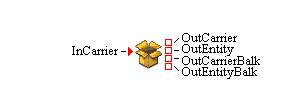Templates
Unbatch Block

Description
The Unbatch block is used to separate individual entities from a batch carrier entity. Carrier entities (populated with a group of zero or more entities by a Batch block) arrive at an Unbatch block through its InCarrier input entity port. The Unbatch block first separates individual entities from the carrier entity. Then it attempts to send the carrier entity (which might or might not be empty depending on whether the Unbatch block separated all of the individual entities from the carrier) out its OutCarrier output entity port. It also attempts to send each of the separated individual entities (if any) out its OutEntity port.
Fixed Ports
- InCarrier
-
Input entity port for carrier entities that contain a batch of zero or more entities.
- OutCarrier
-
Output entity port for a carrier to leave that can be accepted by a downstream block.
- OutEntity
-
Output entity port for each of the individual entities separated from the carrier to leave that can be accepted by a downstream block.
- OutCarrierBalk
-
Output entity port for a carrier to leave that cannot leave using the OutCarrier port.
- OutEntityBalk
-
Output entity port for each of the individual entities separated from the carrier to leave that cannot leave using the OutEntity port.
Properties Dialog Box Controls
- Identify Candidate Entities
-
Use these fields to define the criteria for selecting possible entities to be separated from the carrier. The Unbatch block considers separating from the carrier only entities that satisfy all of the criteria specified in this section.
For Primary Usage, you can select to have either regular entities or resource entities separated from the carrier.
For Entity Type (optional), you can specify the name of a particular entity type for entities to be separated from the carrier.
For Attribute Rule (optional), you can specify a Boolean expression that includes attribute values for entities to be separated from the carrier. You can type the expression in the Attribute Rule field, or you can right-click on the Attribute Rule field and select the Edit option to open the Edit Expression window. For more information about how to write the Boolean expression, see Appendix F: Expressions.
If you select Resource Entity for Primary Usage, then you can specify a Resource State (optional) for entities to be separated from the carrier. Valid values are Functional, Failed, Maintenance, and Offlined. - Unbatch Entities among Candidates
-
Use these fields to specify which entities meeting the criteria specified in the Identify Candidate Entities section should be separated from the carrier.
Begin At specifies where in the buffer of entities to begin separating them from the carrier and attempting to send them out through the OutEntity port. First means to start with the first entity in the buffer and then proceed with the following entities in order, stopping if the end of the buffer is reached. Last means to start with the last entity in the buffer and then proceed backwards through the entities, stopping if the beginning of the buffer is reached. Middle means to start with the entity at the index specified in the entry field and then proceed with the following entities in order, stopping if the end of the buffer is reached.
Count specifies a maximum number of entities to separate from the carrier. Checking All causes any Count value to be ignored. If All is checked and Begin At is set to First or Last, all of the entities that meet the criteria in the Identify Candidate Entities section are separated from the carrier. If All is checked and Begin At is set to Middle, all of the entities except the ones before the specified middle index are separated from the carrier.
Candidates for Design of Experiments
- Factors
-
None
- Responses
-
None